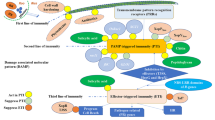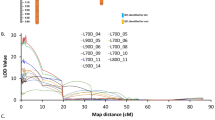Abstract
Oat accessions characterized by multicomponent resistance to Fusarium disease of grain from the collection of the Vavilov All-Russian Research Institute of Plant Industry (VIR) are selected. Resistance of the accessions is evaluated on the basis of three parameters: Fusarium damaged grain (FDG): percent of infected grain, quantity of mycotoxins, and DNA content of trichothecene-producing fungi. Five oat landrace accessions and two cultivars Argamak (Russia) and Kuromi (Japan) are the most resistant to infection of grain and accumulation of mycotoxins.
Similar content being viewed by others
References
Kononenko, G.P., System of Mycotoxicological Monitoring of Objects of Veterinary Sanitary and Ecological Supervision, Extended Abstract of Doctoral Dissertation, Moscow, 2005.
Gavrilova, O.P. and Gagkaeva, T.Yu., A Dangerous Oat Disease—Fusarium Disease of Panicle and Grain, Skh. Vesti, 2008, 2(73), pp. 40–41.
Loskutov, I.G., Oves (Avena L.): rasprostranenie, sistematika, evolyutsiya i selektsionnaya tsennost’ (Oat (Avena L.): Distribution, Taxonomy, Evolution, and Breeding Value), St. Petersburg: GNTs RF VIR, 2007.
European Commission. Community Reference Laboratory for GM Food and Feed. Event-specific for the Quantitation of Maize Lin NK603 Using Real-time PCR, 2005.
Burkin, A.A., Zorjan, V.G., Soboleva, N.A., and Kononenko, G.P., T-2 Toxin and Roridin A in Blood, Tissues, and Excreta of Rats after Oral Administration, Baltic. J. Lab. Anim. Sci., 2000, vol. 10, no. 1, pp. 26–32.
Kononenko, G.P. and Burkin A.A., Experience in Developing and Using Immunoreagents for Analyzing 12,13-Epoxytrichitec-9-n-8-one, Immunopatol. Allergol., Infektol., 2009, vol. 2, p. 16.
Snijders, C.H.A., The Inheritance of Resistance to Head Blight Caused by Fusarium culmorum in Winter Wheat, Euphytica, 1990, vol. 50, pp. 9–17.
Mesterhazy, A., Theory and Practice of the Breeding for Fusarium head blight in wheat, J. App. Gent., 2002, vol. 43A, pp. 289–302.
Boutigni, A-L., Richard-Forget, F., and Barrea, C., Natural Mechanisms for Cereal Resistance to the Accumulation of Fusarium Trichothecenes, Eur. J. Plant. Pathol., 2008, vol. 121, pp. 411–423.
Author information
Authors and Affiliations
Corresponding author
Additional information
Original Russian Text © O.P. Gavrilova, T.Yu. Gagkaeva, I.G. Loskutov, 2012, published in Doklady Rossiiskoi Akademii Sel’skokhozyaistvennykh Nauk, 2012, No. 1, pp. 21–23.
The work was supported by the Russian Foundation for Basic Research (grant no. 08-04-13668-0fi_ts, “To Develop the Technology of Isolating Parent Material for Breeding Oat Varieties Resistant to Fusarium Head Blight and Accumulation of Mycotoxins in Grain”); project of the Nordic Research Board no. 090014, “New Emerging Mycotoxins and Toxigenic Fungi in Northern Europe”; and grants of the Finnish Academy of Sciences no. 126917 and no. 131957.
About this article
Cite this article
Gavrilova, O.P., Gagkaeva, T.Y. & Loskutov, I.G. Screening of parent material for breeding oat varieties resistant to Fusarium disease and accumulation of mycotoxins in grain. Russ. Agricult. Sci. 38, 33–35 (2012). https://doi.org/10.3103/S1068367412010065
Received:
Published:
Issue Date:
DOI: https://doi.org/10.3103/S1068367412010065




